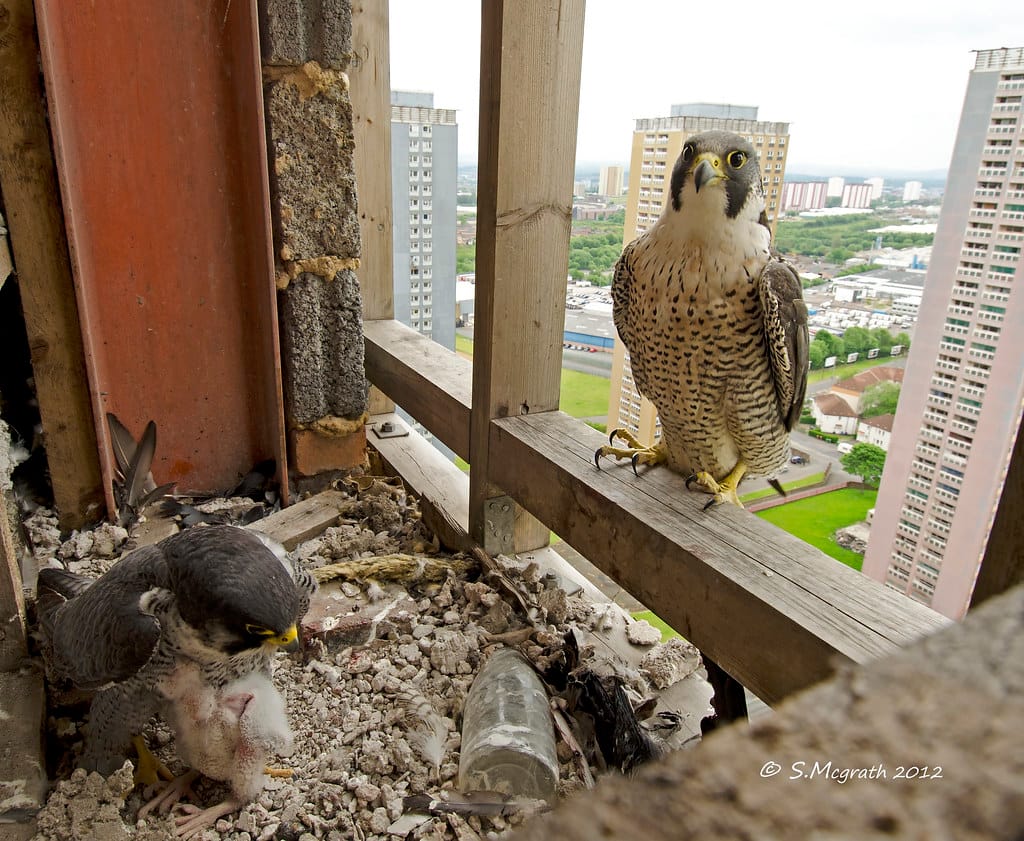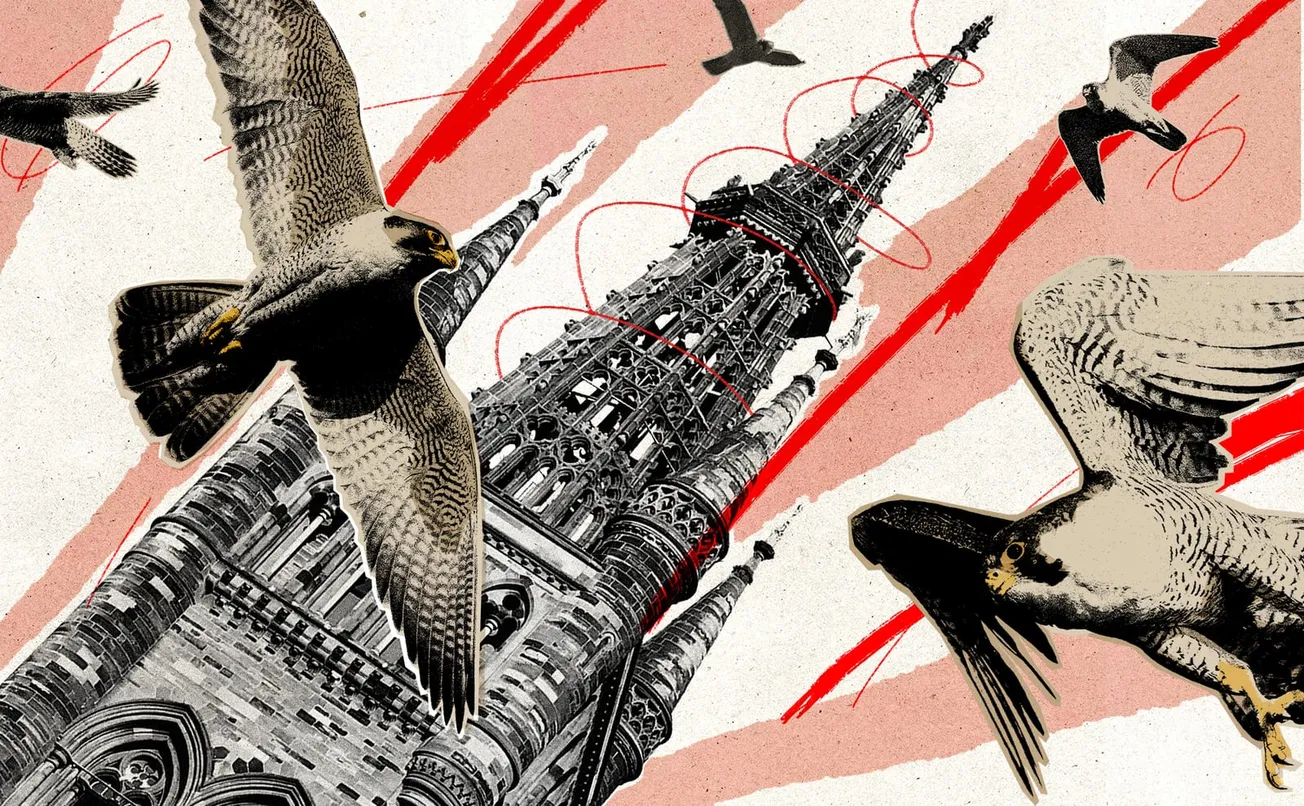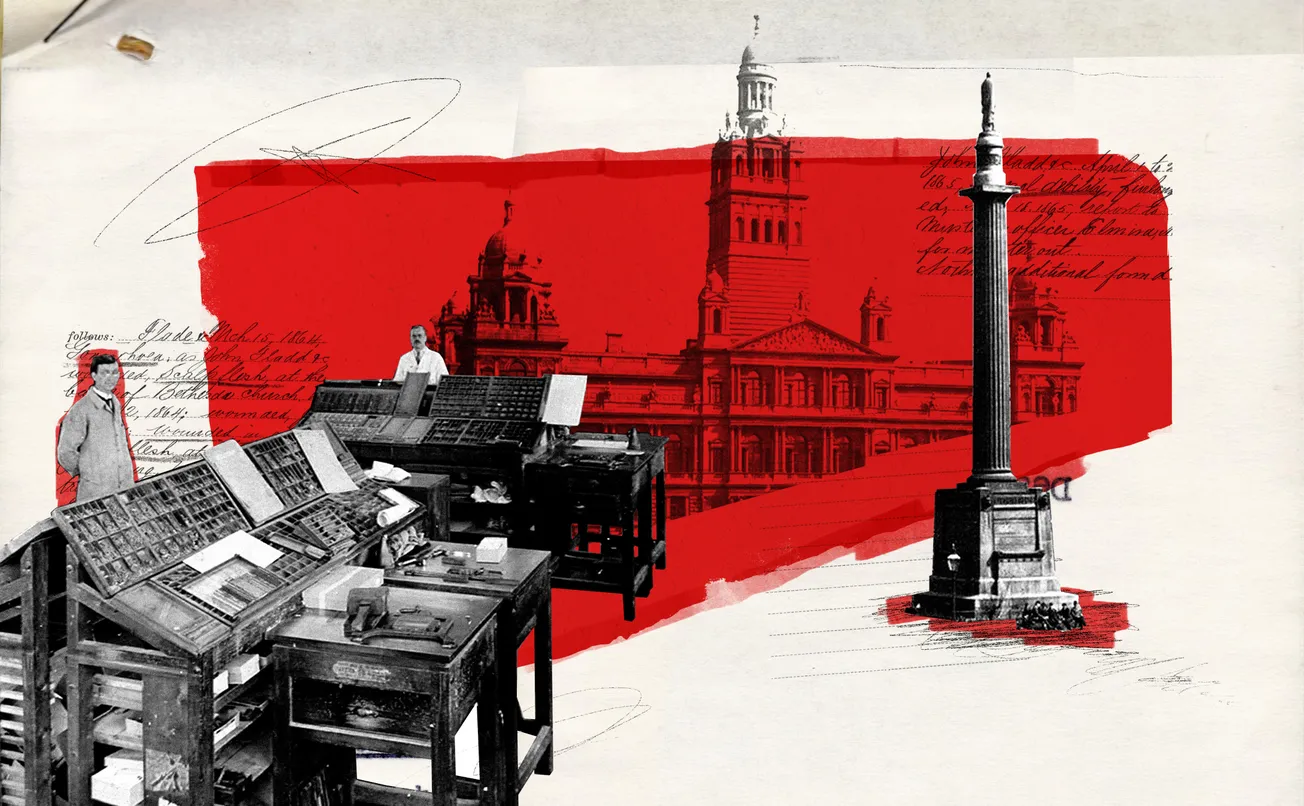Did you know the peregrine falcon is the fastest animal on earth (sorry cheetahs)?
Or that they’re the avian version of Stone Cold Steve Austin, known to smack other birds out of the air, killing them instantly?
Or that populations of peregrine have bounced back since a low in the 1960s when they nearly vanished from the UK? Protected by the Wildlife Act, peregrines have followed human population trends by leaving the countryside in favour of our metropolises, lured by towering buildings with good nesting ledges, and lots of feral pigeons to feed on — apparently their favourite delicacy.
Glasgow has its own pair of nesting peregrines, discovered in 2022. I meet the man responsible — and learn the above list of facts — over a coffee in the Maryhill Tesco Extra cafe. Steven McGrath, the man opposite me, is one of Glasgow’s foremost peregrine experts. He’s spent years painstakingly researching and documenting the city’s raptor population. He’s also a 51 year-old taxi driver from Drumchapel. It’s the tension between these two things that McGrath thinks is responsible for a bitter feud that has developed between himself and the face of the University of Glasgow’s flagship peregrine project — a project that emerged from his work.

McGrath has always been transfixed by birds of prey. He recalls watching kestrels hover and dive for voles as a teenager, then getting his first decent photo of a buzzard. “It all snowballed from there”, he tells me over our brew. Now, he devotes pretty much all his spare time to building nest boxes for kestrels, monitoring the cameras he’s installed at other sites, and going to the university to watch and photograph the peregrines. “I’m passionate about my city and passionate about wildlife”, he concludes, which pretty much sums up Steven McGrath.
But that passion has been soured in the last six months, by events taking place in the human world. This is the story of one man’s love for birds and how he believes it was taken from him.
From Red Road to the West Quadrangle
McGrath’s first successful project with Glasgow’s peregrine falcons was in 2012. Back then, McGrath was staying in the famous Red Road flats, previously the tallest residential buildings in Europe but now condemned for demolition. Leaving for a shift one evening, he spotted a bird of prey swoop over his car and up into another of the Red Road blocks. Immediately he turned his car around and parked up, racing up the stairs to the flat opposite where he’d seen the bird enter the tower.
There were still people living in the flat McGrath wanted to enter but after an excitedly garbled explanation, they let him in. He pulled out his camera and trained it on the spot he thought he’d seen the bird. Incredibly, he realised, it was a peregrine falcon. And there were two, clearly nesting together. He’d never heard of peregrines breeding in Glasgow before.
McGrath was ecstatic but concerned. The flats were scheduled to come down soon — and what would happen to the birds then? He got in touch with the RSPB and kickstarted efforts to protect the pair, resulting in the first recorded hatching of a peregrine falcon chick in Glasgow’s history.
McGrath’s involvement hadn’t ended with the phone call; he helped install a nest box for birds and it was his webcam footage that became a key promotional tool in conservation of the birds.
The birds eventually moved on and Glasgow was bereft of peregines — until McGrath discovered another pair at the Cathedral in 2021. With permission, he again installed a nest box for them, but disaster struck. Their original nest was flooded before the birds moved into the box and instead the pair left the Cathedral spot altogether, abandoning their eggs, which chilled in their absence, putting paid to any new peregrine chicks.
It wasn’t until a frosty morning in January 2022 when hope was revived again.
McGrath was driving in the West End and passed the University of Glasgow’s Gilbert Scott building, which he knew was patronised by many species of bird. He was used to keeping one eye out — and on this day, up near an old raven’s nest, he suddenly spotted the falcons who’d left the Cathedral, perched on a disused chimney.
Sorry to interrupt. We hope you're enjoying this article. We just wanted to let you know that you can get two totally free editions of The Bell in your inbox, every week. That's the Monday briefing — full of news, scoops and recommendations — and the weekend read, which you're perusing right now. Just click the button below to sign up. Again, it's completely free.
McGrath knew the peregrines had to be protected but he didn’t have the jurisdiction. They were on university property. So, after a period of informal calls and interactions with university staff regarding the birds, in June 2022 he sent an email to the estates department of the university alerting them to the peregrines and advising the institution to install a nesting tray. “It would have a good chance at securing the birds for years to come,” McGrath wrote.
McGrath then had a further back and forth with the university, attempting to establish a project. He told them all the information he’d gathered about the pair, including how the female, tagged ‘L7’, had journeyed up from Norwich. Simultaneously, McGrath was working his contacts to try and secure funding to get the birds tagged — by the end of 2022, an old associate at the RSPB had come through. It was then that McGrath received a call that, in retrospect, he believes began the process of transforming his beloved pastime into a nightmare.
“Are you the peregrine man for Glasgow?” the voice on the other end said.
“I had to accept that I’ll never be a part of it”
The man on the phone was called John Simpson, and he was the newly-appointed Clyde Area Local Bird Recorder of the Scottish Ornithologists Club (SOC). Simpson, it transpired, had been approached by the University of Glasgow staff member who McGrath had been corresponding with about the peregrines.
Over a series of calls and emails, Simpson told McGrath he was interested in the project McGrath had proposed to the university and wanted to be involved. The two discussed caring for the birds and how the project to protect them and document their progress might be run. They discussed details about the nest boxes, tagging the birds and setting up cameras at the nest sites for monitoring and publicity. Everything seemed positive. The Glasgow Peregrine Project, as it was dubbed, kicked off in late 2022, branded as a joint venture between the RSPB, the university — and the SOC, via Simpson’s involvement. McGrath was half in the loop, but without any formal involvement.
Yet McGrath’s input was invaluable. “Some ornithological people only “focus on the breeding cycle”, says Brian Morris, a retired programme director and active member of McGrath’s Facebook group, ‘Glasgow Peregrines’. “But Steven and the others are there 12 months a year, touring the city, documenting [the pair’s] every move”. Morris describes the female peregrine, L7, as McGrath’s “sweetheart”, about whom nobody knows more.
There is still a lot that is unknown about peregrine’s lives, such as how and why they travel to such far flung places for new nest sites. Falco peregrinus, the bird’s scientific name, translates to “wandering falcon”. McGrath’s year-round photography built a body of evidence of such movements. And, according to John Simpson in a 2023 Facebook post, McGrath’s pictures and observations: “are a great conservation tool [and] greatly appreciated”
But as the months went on, McGrath received less and less correspondence from the university and John Simpson.
Comments
How to comment:
If you are already a member,
click here to sign in
and leave a comment.
If you aren't a member,
sign up here
to be able to leave a comment.
To add your photo, click here to create a profile on Gravatar.






